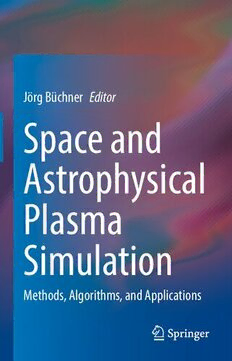Table Of ContentJörg Büchner Editor
Space and
Astrophysical
Plasma
Simulation
Methods, Algorithms, and Applications
Space and Astrophysical Plasma Simulation
Jörg Büchner
Editor
Space and Astrophysical
Plasma Simulation
Methods, Algorithms, and Applications
Editor
JörgBüchner
MaxPlanckInstituteforSolarSystem
Research
Göttingen,Germany
ISBN978-3-031-11869-2 ISBN978-3-031-11870-8 (eBook)
https://doi.org/10.1007/978-3-031-11870-8
©TheEditor(s)(ifapplicable)andTheAuthor(s),underexclusivelicensetoSpringerNatureSwitzerland
AG2023
Thisworkissubjecttocopyright.AllrightsaresolelyandexclusivelylicensedbythePublisher,whether
thewhole orpart ofthematerial isconcerned, specifically therights oftranslation, reprinting, reuse
ofillustrations, recitation, broadcasting, reproductiononmicrofilmsorinanyotherphysicalway,and
transmissionorinformationstorageandretrieval,electronicadaptation,computersoftware,orbysimilar
ordissimilarmethodologynowknownorhereafterdeveloped.
Theuseofgeneraldescriptivenames,registerednames,trademarks,servicemarks,etc.inthispublication
doesnotimply,evenintheabsenceofaspecificstatement,thatsuchnamesareexemptfromtherelevant
protectivelawsandregulationsandthereforefreeforgeneraluse.
Thepublisher,theauthors,andtheeditorsaresafetoassumethattheadviceandinformationinthisbook
arebelievedtobetrueandaccurateatthedateofpublication.Neitherthepublishernortheauthorsor
theeditorsgiveawarranty,expressedorimplied,withrespecttothematerialcontainedhereinorforany
errorsoromissionsthatmayhavebeenmade.Thepublisherremainsneutralwithregardtojurisdictional
claimsinpublishedmapsandinstitutionalaffiliations.
ThisSpringerimprintispublishedbytheregisteredcompanySpringerNatureSwitzerlandAG
Theregisteredcompanyaddressis:Gewerbestrasse11,6330Cham,Switzerland
Thisbookisdedicatedto Maha
Ashour-Abdalla,co-founderof the
InternationalSchoolandSymposiaof Space
Simulation(ISSS), who unfortunatelyleftus
prematurely.Mahaalways cared about
educatingthespacesimulationabilitiesof
earlycareer stagescientists.Shemade
essentialcontributionstotheformationofa
worldwideand nowwell-established
communityofhighlyqualifiedscientistswho
applynumericalsimulationtechniquesto
betterunderstandspaceplasmasthroughout
theUniverse.
Göttingen,Berlin andPotsdam inMay
2022,JörgBüchner
Preface
Afterthe6thInternationalSchoolandSymposiumofSpaceSimulation(ISSS)was
held in Garching(Germany),a collection of its lectures was publishedas Lecture
Notes in Physics (Space Plasma Simulation, Springer-Verlag, Berlin, 2003, eds.
Büchner, J., Dum, C. T. and Scholer, M.). Since then, the book has been widely
distributed and used in many ways used in the space science community as an
introductiontonumericalsimulationmethods.Meanwhilespaceplasmasimulation
techniqueshave beensuccessfully utilized to solveopen questionsconcerningthe
dynamicsofthe hotspace plasmas. As these methodswere furtherdevelopedand
extended, they were applied to understanding the most important phenomena of
the hot plasmas in the universe. Almost 20 years later the editorial departmentof
Springer’s International Publishing felt that a new generation of scientists would
greatly benefit from an updated space and astrophysical plasma simulation book,
containingactualtutorialsofthebasichotplasmasimulationapproaches,introduc-
tionsintonewlydevelopedmethodsandalgorithms,andexamplesofmodernspace
andastrophysicalapplicationsthatbecamepossiblewiththeavailabilityofgreatly
enhancedcomputingfacilities.
Asaresult,we,asagroupofexperts,havecombinedouraccumulatedexpertise
to compile an up-to-date collection of our lectures. Our book aims both at
newcomersaswellasexperiencedscientistswhowanttounderstandstate-of-the-art
simulationmethodsandatthosewhowanttocarryoutnumericalsimulationsfora
betterunderstandingofthecomplexdynamicsofthehotplasmasintheuniverse.In
this sense the chaptersof the bookcan be studied all togetheras a groupbut also
independently.
Nowadays, numericalsimulation is a necessary tool needed to properly under-
stand the highly nonlinear and nonlocal phenomena of collisionless, hot, dilute
spaceandastrophysicalplasmas.Asaresult,inrecentyearswiththedevelopment
of powerful computers, the numerical simulation of hot plasma phenomena has
becomeindispensablefortheirthoroughinvestigation.Simulationstesttheoretical
predictionsandguide the analysisof large-scaleglobalphenomena,andof in situ
observable microscopic processes in space, such as the acceleration of charged
particles and properties of whole plasma systems, such as heating of individual
plasmacomponentsandtheemissionofenergeticelectrons,positrons,ionsaswell
aselectromagneticwavesoverwiderangesofenergiesandfrequencies.
vii
viii Preface
This book introduces in three parts the techniques of the numerical simulation
ofhot,mostlycollisionless,spaceandastrophysicalplasmas.Thefirstpartcontains
tutorialswhichintroducethe mostcommonlyusedplasma models,thealgorithms
of their numerical treatment, and examples of their practical applications. The
secondpartofthebookisdevotedtoadvancedsimulationtechniqueswhichallow
morerealisticinvestigationsofspaceandastrophysicalhotplasmaphenomena.The
third part of the book provides two outlooks on algorithms which are presently
under development to broaden the scope of applicability of numerical simulation
techniques. They are inspired by space plasma simulations but extend far beyond
them.
Allchaptersarewrittenbyexpertswhoareinternationallywell-knownfortheir
original research results and contributions to the field. The contents of the book
chapters are also based on the year-long experience of the authors teaching these
methodsatuniversitiesinEurope,Japan,andtheUSA.Thewholetutorialcourse,
forexample,wastaughtformanyyearsbymembersoftheTheoryandSimulation
of Solar System group of the Max Planck Institute for Solar System Research at
the Georg-August University in Göttingen and at the Center for Astronomy and
AstrophysicsoftheBerlinInstituteofTechnologyinBerlin,Germany,inorderthat
thefeedbackofthestudentscouldbetakenintoaccount.
Asthescientificeditor,Iherebyverymuchthankalltheotherauthorsfortheir
valuable contributions, which helped to make this book so unique. Many thanks
also go to Dr. Lisa Scalone of the SpringerInternationalPublishing house for her
valuable support in technically preparing the volume for print and Dr. Patricio
Munoz for his persistent care about the deposited manuscripts in preparation.
Because every chapter of the book also underwent a careful peer review process,
many thanks also go to the referees, who constructively contributed to improving
thecontentandpresentationofthematerial.
Göttingen,Germany JörgBüchner
May2022
Contents
PartI IntroductiontoBasicKnowledge—Tutorials
1 MagnetohydrodynamicSimulations...................................... 3
AntoniusOtto
2 HallMagnetohydrodynamics.............................................. 29
J.D.Huba
3 Hybrid-KineticApproach:MasslessElectrons.......................... 63
DanWinske,HomaKarimabadi,AriYitzchakLe,NojanNickOmidi,
VadimRoytershteyn,andAdamJohnStanier
4 Gyrokinetics................................................................. 93
FrankJenko
5 Eulerian Approach to Solve the Vlasov Equation and
Hybrid-VlasovSimulations................................................ 123
FrancescoCalifanoandSilvioSergioCerri
6 FullyKineticSimulations:Semi-LagrangianParticle-in-Cell
Codes......................................................................... 163
PatrickKilianandFelixSpanier
PartII IntroductiontoAdvancedSimulationApproaches
7 AdaptiveGlobalMagnetohydrodynamicSimulations.................. 211
Tamas I. Gombosi, Yuxi Chen, Zhenguang Huang,
Ward B. Manchester, Igor Sokolov, Gabor Toth,
andBartvanderHolst
8 MultiscaleKineticSimulations............................................ 255
GiovanniLapenta
9 Hybrid-KineticApproach:InertialElectrons........................... 283
NeerajJain,PatricioA.Muñoz,andJörgBüchner
10 GeneralizedQuasi-NeutralHybrid-KineticSimulations .............. 313
TakanobuAmano
ix
x Contents
11 FullyKinetic(Particle-in-Cell)SimulationofAstrophysical
Plasmas ...................................................................... 337
MasahiroHoshino
PartIII Introduction to Advanced New Algorithms and
DevelopmentsforFutureSimulations
12 Higher-OrderMagnetohydrodynamicSimulations .................... 361
Jean-MathieuTeissierandWolf-ChristianMüller
13 EMAPS: An Intelligent Agent-Based Technology for
SimulationofMultiscaleSystems......................................... 393
YuriOmelchenkoandHomaKarimabadi
Contributors
TakanobuAmano UniversityofTokyo,Tokyo,Japan
Jörg Büchner Max-Planck-Institute for Solar System Research, Göttingen, Ger-
many
Francesco Califano Departmentof Physics “E. Fermi”, Università di Pisa, Pisa,
Italy
YuxiChen DepartmentofClimate andSpace SciencesandEngineering,Univer-
sityofMichigan,AnnArbor,MI,USA
Silvio Cerri Observatoire de la Côte d’Azur, Boulevard de l’Observatoire, Nice,
France
Tamas Gombosi Department of Climate and Space Sciences and Engineering,
UniversityofMichigan,AnnArbor,MI,USA
MasahiroHoshino UniversityofTokyo,Tokyo,Japan
ZhenguangHuang DepartmentofClimateandSpaceSciencesandEngineering,
UniversityofMichigan,AnnArbor,MI,USA
JoeHuba SyntekTechnologies,ArlingtonCounty,VA,USA
NeerajJain CenterforAstronomyandAstrophysics,TechnicalUniversityBerlin,
Berlin,Germany
FrankJenko Max-Planck-InstituteforPlasmaphysics,Garching,Germany
HomaKarimabadi AnalyticsVentures,Inc.,SanDiego,CA,USA
PatrickKilian SpaceScienceInstituteBoulder,CO,USA
GiovanniLapenta CentreforPlasmaAstrophysics,DepartmentofMathematics,
CatholicUniversityofLeuven,Heverlee,Belgium
AriYitzchakLe LosAlamosNationalLaboratory,LosAlamos,NM,USA
Wolf-Christian Müller Center for Astronomy and Astrophysics, Technical Uni-
versityBerlin,Berlin,Germany
xi

